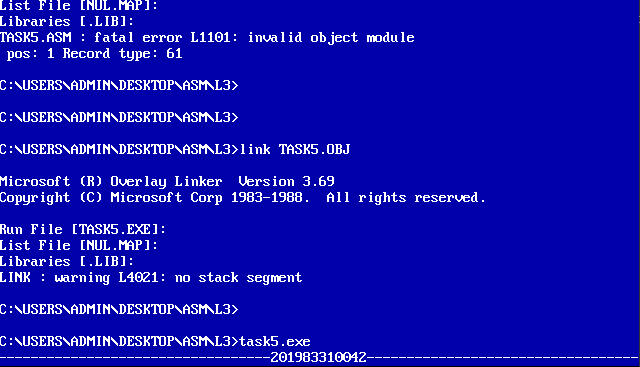Experiment 3 transfer instruction jump principle and its simple application programming
Experiment 1
Using any text editor, enter the 8086 assembler source code task1.asm.
1 assume cs:code, ds:data 2 3 data segment 4 x db 1, 9, 3 5 len1 equ $ - x 6 7 y dw 1, 9, 3 8 len2 equ $ - y ;$Is the offset address of the next data, Equivalent to the current offset value of the segment currently being assembled. 9 data ends 10 11 code segment 12 start: 13 mov ax, data 14 mov ds, ax 15 16 mov si, offset x 17 mov cx, len1 18 mov ah, 2 19 s1:mov dl, [si] 20 or dl, 30h 21 int 21h 22 23 mov dl, ' ' 24 int 21h 25 26 inc si 27 loop s1 28 29 mov ah, 2 30 mov dl, 0ah 31 int 21h 32 33 mov si, offset y 34 mov cx, len2/2 35 mov ah, 2 36 s2:mov dx, [si] 37 or dl, 30h 38 int 21h 39 40 mov dl, ' ' 41 int 21h 42 43 add si, 2 44 loop s2 45 46 mov ah, 4ch 47 int 21h 48 code ends 49 end start
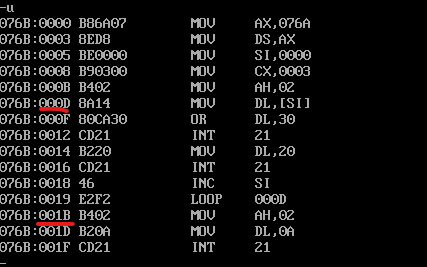
② line44. When the assembly instruction loop s2 jumps, it jumps according to the displacement. Check the machine code through debug disassembly and analyze the jump displacement? (the displacement value is answered in decimal) from the perspective of the CPU, explain how to calculate the offset address of the instruction after the jump label s2.
Displacement: 16=0039h-0029h=10h=16
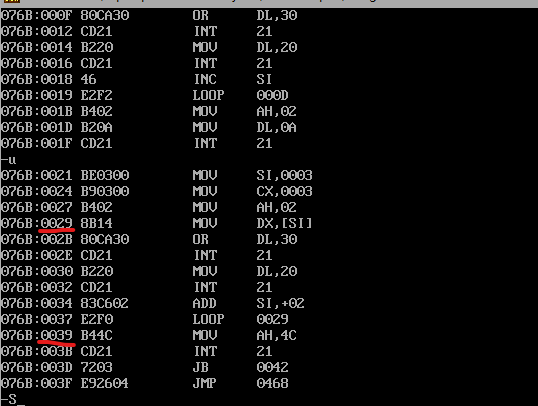
Experiment 2
1 assume cs:code, ds:data 2 3 data segment 4 dw 200h, 0h, 230h, 0h 5 data ends 6 7 stack segment 8 db 16 dup(0) 9 stack ends 10 11 code segment 12 start: 13 mov ax, data 14 mov ds, ax 15 16 mov word ptr ds:[0], offset s1 17 mov word ptr ds:[2], offset s2 18 mov ds:[4], cs 19 20 mov ax, stack 21 mov ss, ax 22 mov sp, 16 23 24 call word ptr ds:[0] 25 s1: pop ax 26 27 call dword ptr ds:[2] 28 s2: pop bx 29 pop cx 30 31 mov ah, 4ch 32 int 21h 33 code ends 34 end start
① According to the jump principle of call instruction, it is analyzed theoretically that before the program executes to exit (line31), register (ax) =? Register (bx) =? Register (cx) =?
ax=0021 bx=0026 cx=076c
Ax refers to the IP when executing s1:pop ax instruction, bx refers to the IP when executing s2:pop bx instruction, and cx refers to the CS when executing s2:pop bx instruction.
call word ptr ds:[0] pushes the IP of the s1:pop ax instruction onto the stack. Then call dword ptr ds:[2] Instruction will S2: the CS and IP of pop bx are successively pushed into the stack, so cx is the bottom of the stack, and bx and ax are at the top of the stack at the end
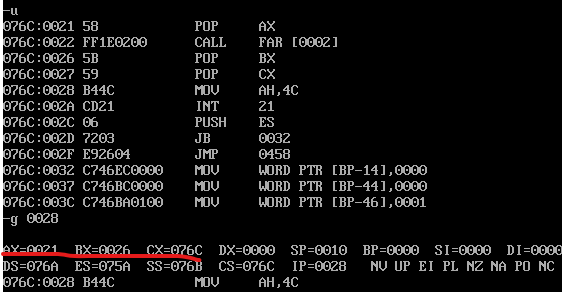
correct
Experiment 3
1 data segment 2 x db 99, 72, 85, 63, 89, 97, 55 3 len equ $- x 4 data ends
1 ; Function: output single character 2 3 mov ah,2 4 mov dl, xx ;xx Is the character to be output, or its ASCII Code value 5 int 21h
Experiment code:
1 assume cs:code, ds:data 2 3 data segment 4 x db 99, 72, 85, 63, 89, 97, 55 5 len equ $-x 6 data ends 7 8 code segment 9 start: 10 mov ax, data 11 mov ds, ax 12 mov si, 0 13 mov bl, 10 ;16 14 mov cx, len 15 16 s: mov al, ds:[si] 17 mov ah, 0 18 inc si 19 call printNumber 20 call printSpace 21 loop s 22 23 mov ah, 4ch 24 int 21h 25 26 printNumber: 27 div bl 28 mov dx,ax 29 30 or dl, 30h 31 or dh, 30h 32 33 mov ah, 2;The remaining bits are high 34 ;dl 35 int 21h 36 37 mov dl, dh 38 int 21h 39 40 printSpace: 41 mov ah, 2 42 mov dl, 32 43 int 21h 44 ret 45 46 code ends 47 end start
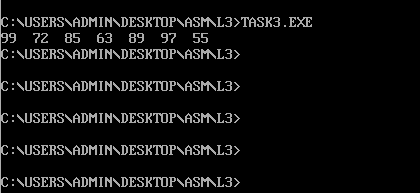
Experiment 4
1 data segment 2 str db 'try' 3 len equ $ - str 4 data ends

1 assume cs:code, ds:data 2 data segment 3 str db 'try' 4 len equ $ - str 5 data ends 6 7 code segment 8 start: 9 mov ax, data 10 mov ds, ax 11 mov ax,0b800h 12 mov es,ax 13 14 mov si,offset str 15 mov cx,len 16 mov bh, 0 ;Action line 1 17 mov bl, 2 ;The string color is green on a black background 18 call printStr 19 20 mov si,offset str 21 mov cx,len 22 mov bl, 4 ; Specifies that the string color is red on a black background 23 mov bh, 24 ;Specify the last line of the behavior 24 call printStr 25 26 mov ah, 4ch 27 int 21h 28 29 printStr: 30 mov al, 160 31 mul bh 32 mov di, ax 33 34 s: mov ah, ds:[si];Take character 35 mov es:[di], ah;character es High 8 bits 36 inc di 37 mov es:[di], bl;colour 38 inc di 39 inc si 40 loop s 41 ret 42 43 code ends 44 end start
Experiment 5
For 8086 CPU, the known logical segment is defined as follows:data segment stu_no db '20498329042' len = $ - stu_no data ends
1 assume ds:data, cs:code 2 3 data segment 4 stu db '201983310042' 5 len = $ - stu 6 data ends 7 8 code segment 9 start: 10 mov ax,0b800h 11 mov es,ax 12 mov bp,1 13 mov cx,8000h 14 mov ax,data 15 mov ds,ax 16 17 s: 18 mov byte ptr es:[bp],00011111B 19 add bp,2 20 loop s 21 22 mov ax,0050h 23 sub ax,len;Lose length 24 mov bh,02h 25 div bh 26 mov bl,al;merchant 27 mov bh,0 28 29 mov ax,0b800h 30 mov es,ax 31 mov bp,0F00h 32 mov cx,bx 33 34 p1: 35 mov byte ptr es:[bp],'-' 36 inc bp 37 inc bp 38 loop p1 39 40 mov cx,len;Student number in the middle 41 mov di,0 42 43 s1: 44 mov al,ds:[di] 45 mov es:[bp],al 46 inc bp 47 inc bp 48 inc di 49 loop s1 50 51 mov cx,bx 52 53 p2: 54 mov byte ptr es:[bp],'-' 55 inc bp 56 inc bp 57 loop p2 58 59 mov ax,4c00h 60 int 21h 61 62 code ends 63 end start
